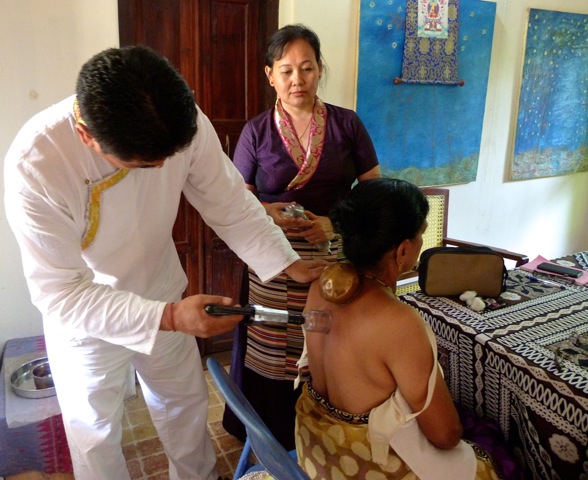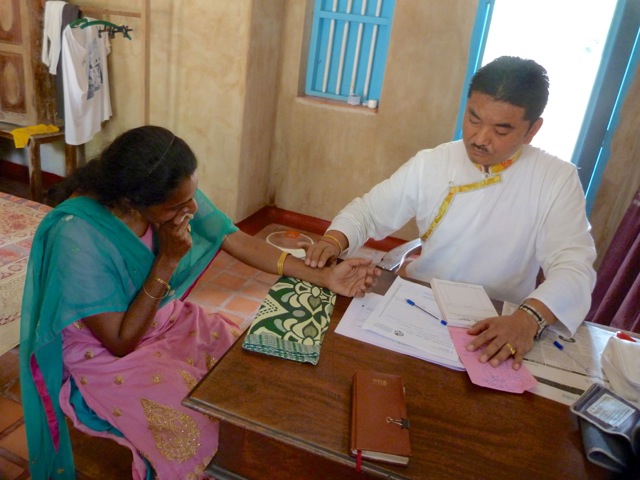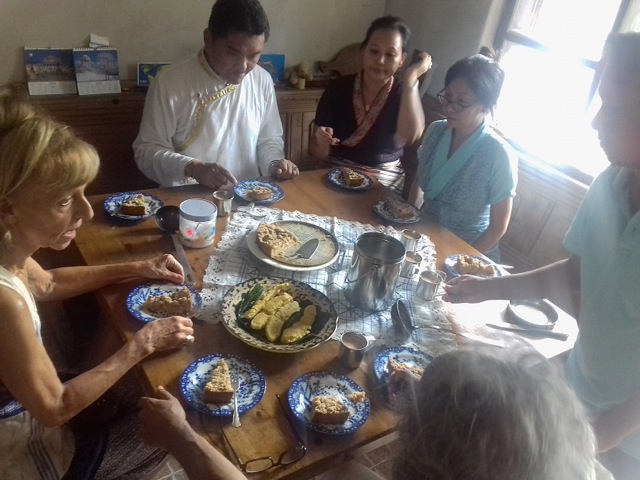The remote fishermen’s beach with the well-sounding name ‘Samudra’ close to Trivandrum was my Indian domicile for some years – long time back. Sitting on the flat roof of a little guest house, I was writing without any disturbance from sunrise to sunset, always the sound of breaking waves in my ears and the fishermen‘s activities at the beach ‘Big Ocean‘ in front of my eyes.
Actually the story begins here at this spot in the South of Kerala in January 1995. There I had a significant experience:
I became the witness of a dancing God …
At that very moment, not yet recognised by me, the search for the dancing God began to form a rough shape. At the neighbouring site the first ‘Village Fair‘ took place, a staged village festival of the olden times – two weeks play and fun with dancing Gods and raging demons, folk art of all kinds, rituals for fertility, archaic fire and war dances …
I‘ve never seen many of them before.
Suddenly, a female dancer fell out of the row. It looked funny to me, I had to laugh. While the other dancers continued to follow the choreography, this dancer was acting the clown, who had forgotten the steps and nevertheless went on dancing. Then at once her behaviour became wilder and my laughter froze. Uncontrolled energies chased her across the stage. Once she passed by in front of me. Her wide-open eyes had no iris. I was frightened. I don‘t know why. At this moment, my thoughts switched off. My eyes have never seen before those things that were going on there.
Time has stopped. Only vague images and emotions are conserved in my memory. When finally the performance was going to end, singing and music ceased, the trance dancer fell down like a stick, at first lying motionless on the ground, then kicking and waving her arms and legs about. Singers and musicians hurried to her and they had to hold her tightly to pour water into her mouth.
Suddenly there was this announcement breaking off this evening performance, and whisperings passed from ear to ear:
»Shiva … Shiva …«
I couldn‘t grasp anything at all.
»Shiva … Shiva …« the fishermen murmured and went on quietly on their way home.
Pushed out to the beach by this mumbling crowd, I woke up slowly from that silent trance, and with the dramaturgy of an approaching thunderstorm, I became aware of what had happened:
Shiva had been here! A God had danced for us humans!
The time passed. That woman‘s dance in trance didn‘t go off my mind.
Six and half years after her unforgettable performance at the fishermen‘s beach named Samudra in 1995, I decided to search for her. Neither did I know her name, nor her adress. I only knew that she used to live in the Pandalam district and that she had broken her toe during her wild dance in trance.
With these two bits of information, I set off on a morning in the summer of 2001, to find her in the jungle of the keralite cultural landscape, the nameless one, who left behind such deep traces in my memory.
The search goes on quite smoothly, as if an invisible thread would lead me straight to her place. Evidently, this dancing God has no objections to my visit.
In a remote village I face her for the first time hearing her deep voice. Now she has got a name: Subhrada. Morning-light!
That wiry tiny man is Guru Kutty Ashan, her father and master. His name suits him: Teacher Little Master!
I am excited, today I will learn the first steps.
Her sister Susheela will sing.
The class starts with the ritual, which initiates the student into the art of dance by the master: the blessing. Subhrada stands in front of me facing East, I turn to face her, like I had seen her doing and the dancers once. Only after that do I become her authorized student and she, my master.
The steps are easy. The dance consists of just three combinations of steps. At the beginning the rhythm is slow then increases in ferocity towards the end.
I do not know as yet, what I am dancing.
Later, in the short intervals, name and meaning are explained to me piece by piece: Pakkanar-thullal.
What a surprise! It was not Shiva who was dancing at the fishermen‘s beach in 1995, but another dancing God. His name is Pakkanar!
Pakkanar-thullal! Thullal means ‘to move’. Pakkanar doesn‘t dance, Pakkanar moves.
The culture of the Paraya is never to find in books, their knowledge travelled from mouth to mouth through the generations.
So I am depending on what the Paraya will tell us, they are the only ones able to speak about it.
Guru Kutty Ashan and his family are the descendants of these basket-makers.
The Paraya’s old tradition as basket makers seems to explain why the Koolam, the painted triangle carried on the dancers’ head during the Pakkanar-thullal is woven by rattan. The costume is made by ‘Kuruthola‘, tender coconut leaves. Due to their bright and pale yellow colour the tender palm-leaves were considered as something pure, precious.
»Pakkanar-Thullal is a divine dance,« explains Kutty Ashan, »and Kuruthola a divine symbol.«
This was the gold of the caste-less people to whom in the past real gold and shining metals were forbidden. Instead of that, they possessed something else, which the rich caste members didn‘t have: shaman power!
Like once with Pakkanar and Vishnu, who had forgotten his childhood friend’s name. The song tells all about it …
Only Pakkanar had the power to curse the highest God and to take it back afterwards! The Paraya had declared him to be their mighty protecting spirit. Their dancers once knew to use his energy, so they were sought-after shamans in olden times. Guru Kutty Ashan is one of the last.
Probably he is the only Paraya who still knows to quote each line of every story completely. He is quite talkative, and tireless in answering my questions. None of our conversations becomes a strain on him or bores him even, he is happy, when he can recount.
How does this shamanism work? And thereby the trance?
How do the dancers reach this change of consciousness, and what do they feel in this condition?
This experience is difficult to describe, they answer, but try it nevertheless.
»It is something appealing, tremendously impressive … a pleasant event to be touched by the spirit of the God ‘who knows the cosmic‘ … The song is very powerful, the singing and the drumming, but when the music stops the trance also will end. We are in another world … How is it possible to express in words …«
Nobody is able to do it; dancing with Pakkanar is a mystery and simultaneously it is a part of the practical life of the Paraya.
What kind of authorities are these? Gods? Spirits? Demons?
Susheela calls them ‘ancestral spirits’; their portraits are painted on the Koolam.
There is the Koolam of Pakkanar and his wife Pakkathya, of two Goddesses, one of them is Vana-devada the forest Goddess, then of Vishnu and the Pinniozhikal-Koolam.
Only the master decides who should dance with which ‘spirit‘.
»I cannot describe this ecstasy and this happiness,« says Subhrada, »this condition I am experiencing is something special, exceptional. After that everything becomes normal again, but I am very energetic.
It is a magnificent feeling to receive this energy, because the spirit has accepted what I have done for it: pray and believe! That’s why I get into this trance. Somebody who just dances will never be given this spirit.
Before starting the Pakkanar-thullal, my father prays and blesses the dancers, each one with a different spirit. Kalari-Para-Devada has been the Goddess of his Guru; now she is the main Goddess of our Kalari. By asking her for her blessings to each of his dancers, he blesses the dancers.
Like that, I too get Pakkanar‘s spirit.«
At just fifteen, she got her father‘s permission to publicly perform the Pakkanar-thullal as a first woman. Normally only men dance the Pakkanar-thullal. But Guru Kutty Ashan made an exeption. That his daughter had an unusual talent, he had soon realised. Furthermore he has no son, only daughters.
The word Pakkanar is made up of ‘Pakkan‘ and ‘are‘. ‘Are‘ means ‘who’ in Malayalam language, that is ‘Pakkan are’ – Who is Pakkan? At the same time, his name is the question: Who is he?
This unfolds in a most simple way, how difficult it is for the humans to name God. He is not conceivable! He is the great enigma! Probably that will never change.
Nevertheless trying it again and again may be an archaic need of us humans.
Even if it mostly doesn‘t seem like it, it is our permanent concern.
Every culture searches for it in their own way.
May all God‘s names lead back to that origin of not being able to call, to imagine? … To the question: Who is it, this invisible power?
The Paraya solved the problem by formulating the question: Pakkan-are? Pakkanar! Each time they pronounce his name, they ask in real: Who is he?
Kutty Ashan is a patient teacher, who is the happiest with curious students. And I? I’m the ideal student for him, because I’m very curious!
»… Without knowing beforehand,« he explains, »the dancer being in trance enters a completely different reality. He is able to look into other people, he can see who is carrying a bad demon inside, and then to take it out … The trance doesn‘t remain in the body afterwards, but if the singing starts again, he would return into the trance …
The song is very important, the belief, the devotion, the respect, the blessing … and the fasting too before the performance.
When somebody is possessed by a demon and I sing the song, then this bad spirit in the person gets dizzy … because the demon feels disturbed by the song of the Goddess and turns aggressive. Now the dancer can pull out the demon.«
What about him, Kutty Ashan? Can’t the bhada enter him while the pulling-out?
He laughs. He cannot come to any harm by the demons and bad spirits, he says. Due to the Koolam on his head, he is under the protection of Pakkanar, through whom will come only good spirits, and besides, the powerful Badrakali is his Goddess.
I am lucky, because I‘m singing songs of the Goddess!
… Without her I am nothing! I receive all energy from her.«
Kutty Ashan wants to see what I have learned.
In accordance with the custom, he blesses me. Then he introduces me to the Pakkanar-thullal.
I’ve never exspected such a thing. I thought I would dance with Subhrada alone.
It takes a great effort to understand my situation. A whole village is singing there with united passion and I, a beginner from Germany, am dancing the dance of their God with the venerable old master in front of their eyes!
The way Guru Kutty Ashan looks at me is touching. He seems to be much younger while dancing.
I feel like in a dream, completely being involved in the scene and yet only watching …
Shortly afterwards we have to dance Mudiyattam.
I comprehend: Mudiyattam, swinging of the hair! This will be the first time for me …
In the beginning, I am surprised how easy it is. And it‘s fun to hurl my hair through the air so wildly.
Soon however the ground under my legs is beginning to shake, the continuous up and down movements with the head and upper part of the body rob me of my balance.
This is ‘attam‘! Besides ‘to swing‘ it also means ‘to shake‘.
»Mudiyattam pleases the Goddess, who will then bless the childless woman.« says Kutty Ashan, »Even if she is possessed by a bad spirit, the Mudiyattam Song can release her from that. When we perform Mudiyattam, the hair itself becomes veneration. Even the women who are watching begin to dance, because of the powerful song.
Close to the village there is a big old ‘Cavu‘ still existing, a mini-forest spared by the axes as a last remnant of the old snake’s realm.
It has the status of a shrine.
You have to take off your shoes like in a temple, this place is sacred.
Through the unspectacular opening in the jungle, we enter this rare relic of primeval times.
A path overgrown with thick roots like enormous arms is leading down steeply; you have to take care not to stumble. I avoid every unnecessary step, countless finger-thick millipedes of a dark brown color curl up on the ground.
The pleasant cool dusk deep in the bowels of the archaic vegetation has a calming effect. Huge forest trees and gigantic lianas form the walls of this natural temple.
Down on the free space covered with dry leaves is the holy centre.
This enchanted silence arouses respect, also the sight of the two ancient stone figures, one of them a topless Goddess with snakes around her head and shoulders. Many times touched, black and greasy, they stand on big stone bases and defy the transitoriness.
This is the divine snake couple, Naga-yakshi and Naga-raja.
… Childlike astonishment is above any intelligent doubt: This is really the home of the snake deity! Here the mother-cult stayed alive for thousands of years. The Cavu is a place of life and ancient stories.
I’ve never seen a comparable Cavu; perhaps there is none of that kind anymore. It is a part of the village life, strangers will never come here.
… The last breath of an old world is perceptible here.
I inhale it deeply …
Here there is still enough space for any story!
I realise being at a special place, which has become quite rare, one of the last living cells of diversity, having escaped the sharp knife of monoculture, far away from the radical modern age.
Today they want to perform the Pakkanar-thullal in costumes and with all decorations, because today is our last day.
Nobody has brought something for eating or drinking. Everyone is sitting there just watching. No one did plan anything else, no one needs more.
»… It’s only the belief!« says Kutty Ashan.
With quite some delay, this sentence touches my thoughts:
… it is only the belief!
Pictures and texts are excerpts from the Documentary Film
Searching for the Dancing God – Kerala‘s last Shaman
by Sylvie Bantle
– in cooperation with the South-Indian Artist Alexander Devasia
2007, 99 min., original language Malayalam, language of Voice Over + subtitle English
on Youtube:
Dokumentarfilm in Deutsch
Die Suche nach dem tanzenden Gott – Keralas letzter Schamane
auf Youtube:
Das Buch von Sylvie Bantle
Die Suche nach dem tanzenden Gott – Keralas letzter Schamane
gibt es (leider) nur in deutscher Sprache
The location is around 50 km southwest from Sylviander House
Sylviander House
Eco Homestay & Art Museum
Chettikad – Alappuzha – Kerala – South-India


























































